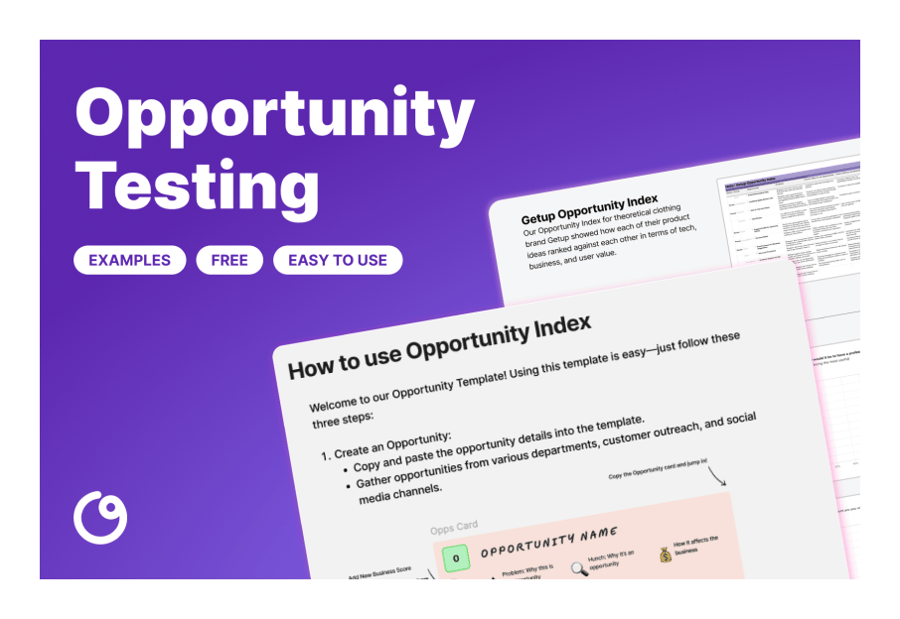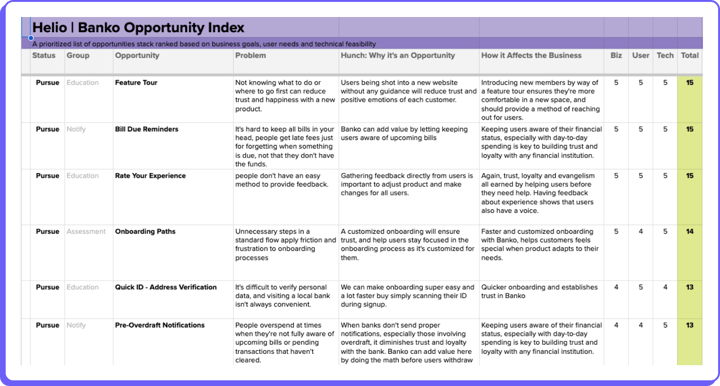Uncover market opportunities
Find new opportunities and meet unmet user needs to strengthen your market position.


Understand User Needs
Spot new opportunities by understanding what users want. Use these insights to refine your strategies.
Identify Strategic Entry Points
Find unmet needs in your market and discover where your company can step in and succeed.
Enhance Strategic Planning
User insights to guide your strategic planning and make informed decisions to boost your market position.
Map to UX Metrics
Desirability

Frequency of Use
Reaction

Net Promoter Score (NPS)
Explore a Relevant Case Study
How to Identify and Validate Opportunities

Define Your Research Objectives and Methods
Clearly articulate what you aim to discover about potential market opportunities.
Select the most appropriate research methods for gathering data on opportunities.

Design and Analyze Your Questionnaire
Gather data on customer behavior, preferences, and market trends.
Synthesize your data to uncover patterns and insights related to potential opportunities.

Assess Feasibility, Make Data-Drive Decisions
Evaluate the technical feasibility and business impact of the proposed opportunities.
Provide actionable recommendations based on your research and analysis.

Implement, Monitor, and Measure
Track the implementation and success of the validated opportunities.
Business questions that can be addressed with user needs analysis
Here are some common business questions product and marketing leaders ask that can be addressed with brand tracking:
To find gaps in user needs that you can fulfill, start by analyzing user feedback through unmoderated surveys to uncover unmet needs quickly. Helio’s Opportunity Index highlights potential opportunities by considering business goals, user needs, and technical feasibility, giving you a comprehensive understanding of each opportunity.
For example, Banko used the Opportunity Index to analyze market research, customer feedback, and team insights. They discovered that users preferred feature tours, bill reminders, and the ability to rate experiences, aligning with their business and technical needs.
Systematically identifying and prioritizing these opportunities ensures your development efforts match market demands. This method helps you address current gaps and positions you to meet future user expectations, fostering long-term customer loyalty and business growth.
Helio survey panels are essential to uncover unmet user needs, Conducting unmoderated surveys lets you quickly gather feedback and identify gaps before developing solutions. These insights provide a clear direction for understanding user expectations and challenges.
Helio’s Likert questions are valuable for this process. They help reveal user preferences and issues by asking participants about potential features. For example, a survey on ID verification can show what users prefer and their pain points, making it easier to prioritize opportunities.
You can pinpoint the greatest needs by comparing responses to these Likert questions. This approach addresses current gaps and prepares you to meet future user expectations. Focusing on user feedback and market research enhances user satisfaction and supports effective growth before you start creating.
To stand out, address user needs, develop solutions that target these needs, and gather quick user feedback. Tools like Helio help you prioritize opportunities by considering business goals, technology, and user needs.
Banko’s example shows how a single score can help prioritize opportunities by ensuring all aspects are considered. They identified user desires for features like bill reminders and streamlined onboarding paths, aligning with user and business needs.
Focusing on user satisfaction and addressing specific gaps can help you differentiate from competitors. This strategy helps meet current demands and positions you to anticipate and fulfill future user expectations, enhancing user loyalty and business growth.
Stay ahead by using scenario planning to anticipate changes in user needs and market conditions. This method helps you develop proactive strategies that align with future demands.
For instance, Skin Savvy used scenario planning to understand their customers’ preferences. Their action map showed that customers preferred using a website over an app for key actions like signing up, browsing articles, and saving content.
Helio can assist by creating an action map to see what platforms your customers prefer. This insight allows you to tailor your strategies to effectively meet user needs, keeping you competitive and responsive to market changes. By focusing on scenario planning, you can uncover new opportunities and better prepare for evolving user trends.
We can receive feedback and connect with our Providers on high-priority initiatives to the business before executing.

Angeliki King, Hydrafacial
Testing Template Examples
FAQs
User needs analysis involves evaluating users’ specific needs and preferences to uncover market opportunities. This process helps businesses identify where to fulfill unmet needs and better meet user expectations.
Identifying user needs is crucial because it enables businesses to find new growth areas, stay ahead of competitors, and adapt to changing user preferences. It helps in making informed strategic decisions and maintaining a competitive edge.
Common methods include market surveys, which gather data on user preferences and needs; user interviews, which gain qualitative insights through detailed conversations with users; needs assessments, which identify specific unmet needs; and feedback analysis, which analyzes responses to identify patterns and preferences.
User needs analysis specifically focuses on understanding user needs and identifying market opportunities based on those needs. In contrast, other research types might address broader issues, such as overall market trends or customer satisfaction.
Challenges include gathering comprehensive and accurate data, ensuring insights reflect the target market, interpreting diverse data sources, and integrating findings into strategic planning without causing disruptions.
Businesses can use insights to refine their strategies, develop new products or services that meet unmet needs, improve their market positioning, and proactively respond to user trends.
Effective user needs analysis leads to targeted strategies that better meet user needs, improved market positioning by addressing unmet needs, and enhanced ability to anticipate and respond to changes in user behavior.
Success can be measured through KPIs such as opportunity identification rate, user satisfaction improvement, market penetration rate, and strategic implementation rate, which indicate the effectiveness of integrating insights into strategic planning and execution.






